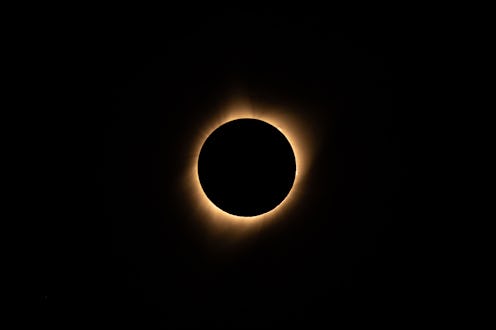Life
How To See The Annular Solar Eclipse On Feb. 26

This month, the new Moon on its orbital tilt is set to pass between the Earth and the Sun, transforming the ball of fire into a brilliant ring of light. But astronomy buffs will want to know how to see the 2017 annular solar eclipse on on Feb. 26 — because most of the world's population will have to do quite a bit more than just "look up" to witness this remarkable celestial event. But with a little ingenuity (or, y'know, access to a livestream), you should still be able to witness this gorgeous, fiery event.
The lucky folks in the southern hemisphere will have a prime spot to view this partial eclipsing of the sun's rays, but for those of us on the other side of the globe, next Monday's solar eclipse will not visible to the naked eye even with protective lenses. Those residing in the United States should take heart, however, as in just a matter of months, a total solar eclipse is set to occur on Aug. 21. It will be the first one to be viewed from the United States in nearly four decades, pitching states from Oregon to South Carolina into some unusual darkness.
Unlike August's total solar eclipse, the annular solar eclipse will not entirely blot out the Sun. Annular solar eclipses occur when a celestial body obscures most of our view of the Sun, but leaves a bright halo of light around the edges known as the "annulus" (Latin for "ring"). The Moon is farther away from the Earth at this point in its orbit, so it looks smaller when directly aligned with the Sun, thus producing the circular light effect sometimes referred to as a "ring of fire." Dramatic, eh?
For those interested in watching this rare celestial phenomenon unfold, follow these step-by-step guide to watch the annular solar eclipse this year:
1Be In The Southern Hemisphere
While the full annular solar eclipse will only be visible along a narrow strip of Earth, most of Africa and South America will be able to see a partial eclipse on Feb. 26. According to the Mirror, "The eclipse will begin in Chile and pass over Argentina's Patagonia region before being visible across the South Atlantic Ocean and eventually in Angola." Once it crosses the ocean and enters Africa, it tapers off near Zambia and the Democratic Republic of Congo. If, for some reason, you find yourself on a cruise, parts of the Pacific, Atlantic, and Indian Ocean, will be able to view part of the eclipse along with the Antarctic — so prepare for some for some freaked out penguins.
2Mark Your Calendar And Set An Alarm
The eclipse is set to begin on Feb. 26 at 7:10 a.m. ET, according to the website Time and Date. As the Sun and Moon reach perfect alignment, the full eclipse will kick off an hour later at 8:15 a.m. ET. The maximum eclipse will peak a few minutes before 10 a.m., completing its journey at 12:35 p.m. Those watching on a live cam will want to grab their coffee and tune in before lunch to catch the brilliant ring of fire hovering in the sky.
3Use Proper Eye Protection
Those observing the eclipse in person will need to prepare ahead of time to safely stare at the Sun. Powerful UV rays, even when partially blocked, can burn the eyes’ sensitive retinas. Without proper protection even short exposure can lead to permanent vision damage or blindness. Sunglasses will not be strong enough to filter the direct rays. Instead, use a projector to display the sun’s image on a piece of paper. You can also buy specialty eclipse glasses or a solar filter designed for eclipses.
4Livestream The Event

For those looking to get in on the fun who aren't in the right part of the globe to see it in person, you can watch the trajectory of the annular eclipse from the comfort of your very own computer. The Slooh Telescope Live show will be broadcasting different angles of this celestial event, so you can get a good look at the sun without the special glasses — or traveling halfway around the world.